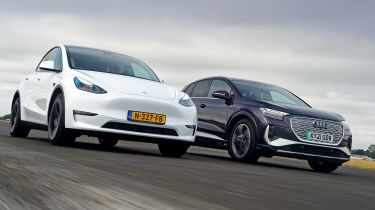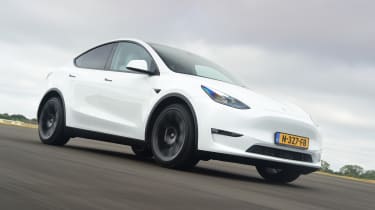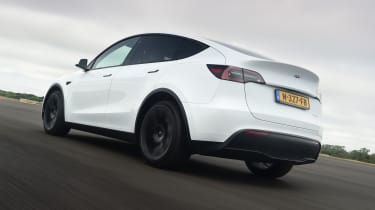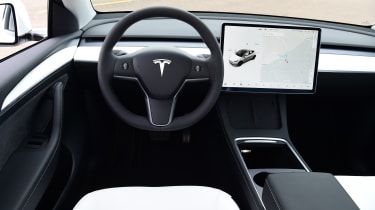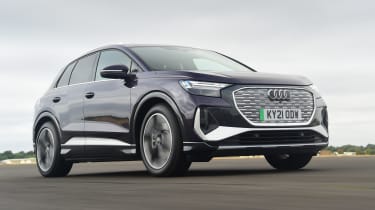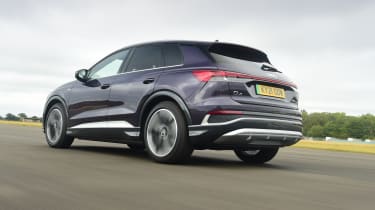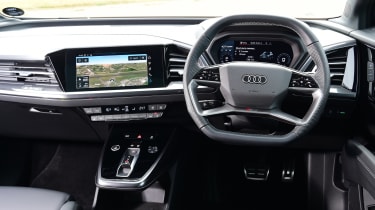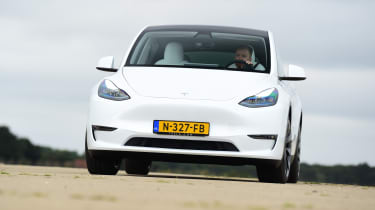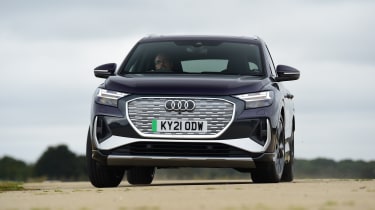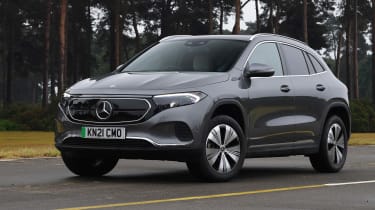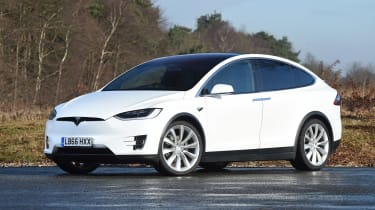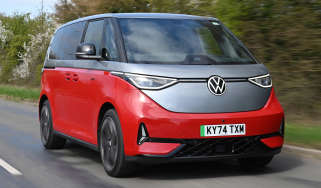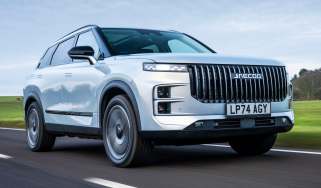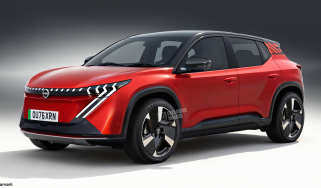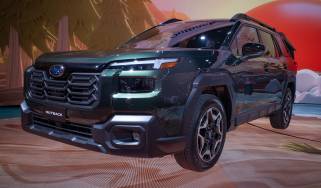Tesla Model Y vs Audi Q4 e-tron: 2021 group test review
The new Tesla Model Y comes with high expectations, so can it brush aside the Audi Q4 e-tron?
Tesla has gone from being an EV upstart to the standard by which all other electric cars are judged. So while the hype machine goes into overdrive when the company launches a new model, its products are worthy of closer scrutiny.
Its latest arrival in the UK is the Model Y, an SUV based on the same tech and running gear as the Model 3 saloon, which is a car that has been awarded with plenty of honours here at Auto Express. The Model Y offers more space than that car, thanks to a bigger body, while retaining its on-board tech and the benefits of Tesla’s Supercharger network, which will all but eliminate range anxiety for potential EV buyers.
Here we test the new Model Y against another relative newcomer to the medium-sized electric SUV class, the Audi Q4 e-tron. It’s the smallest and most affordable model in the firm’s electric line-up, but we’re trying the most powerful version here, which is also the only one with quattro four-wheel drive.
These two are similar on price, and there’s not very much between them for performance, kit or space – so which one can set the class benchmark?
Tesla Model Y
| Model: |
Tesla Model Y Long Range AWD |
| Price: | £54,990 |
| Powertrain: |
2x electric motor, 434bhp (est) |
| 0-62mph: | 5.0 seconds |
| Test economy: | 3.8m/kWh |
| Range: | 315 miles |
| Annual road tax. | £0 |
A variety of premium electric SUVs have been launched in recent months, but the new Tesla Model Y is arguably the most important of the lot. We’re driving a European-spec, left-hand-drive
Long Range AWD car for this test. UK deliveries are scheduled to start at the beginning of 2022.
Used - available now

2023 Tesla
Model Y
30,628 milesAutomaticElectric
Cash £28,000
2023 Tesla
Model Y
24,049 milesAutomaticElectric
Cash £28,644
2023 Tesla
Model Y
26,709 milesAutomaticElectric
Cash £26,700
2023 Tesla
Model Y
28,950 milesAutomaticElectric
Cash £24,800Design & engineering
Cynics will look at the Tesla Model Y and simply dismiss it as a pumped-up Model 3, and in reality that’s largely true. Tesla states that the cars share 95 per cent of their tech, while the styling clearly follows a similar template. The main differences on the Model Yare a raised ride height, a bit of extra bodywork, a taller roof and some black plastic trim for the door sills and wheelarches.
Under the skin, the Model Y features the latest Model 3 platform, so it benefits from a more efficient heat pump to warm the cabin. The Model Y’s larger size means its battery range isn’t quite as long as the Model 3’s, although it can still travel further than the Q4 e-tron on a full charge. Our Long Range AWD model comes with electric motors front and rear, and while power figures haven’t been released, the Model Y has a faster 0-62mph time than the Audi, managing the sprint in 5.0 seconds exactly, more than a second faster than its rival here.
Inside, the Tesla’s minimalist cabin is dominated by the 15.4-inch touchscreen on the dashboard. There are no dials or head-up display for the driver; instead you need to glance across to the big screen for driving information. The cabin is largely button-free, with the only physical controls being the steering wheel (with a pair of multifunction switches), the column stalks, the electric window controls and push-button door openers.
The other significant tech on board is Tesla’s Autopilot system. This comprises a suite of cameras and sensors that constantly scan your surroundings and relay images on the touchscreen, while offering advanced cruise control functions, most of which you are able to unlock as post-purchase options. The standard adaptive system is effective, but Auto Steer still needs a little work. While it manages to detect traffic cones and even the faintest road markings pretty easily, it also picks out overbanding and other scars on the tarmac that can cause confusion.
Tesla’s tech is impressive, but the company’s reputation for build quality isn’t strong. Our test car had a minor rattle from the rear headrests, which was remedied by lowering them back into place, but overall it felt solid and there was no sign of the inconsistent shut lines or mismatched panels that have been seen on other cars from the firm.
Driving
If you’re signed into your Model Y with the smartphone app, then the car unlocks and turns on as soon as it detects your phone on you, before you even pull on the flush-fitting doorhandle. If you haven’t got your phone, then there’s a smartcard that unlocks the car when you hold it against the car’s B-pillar.
Tesla has built a reputation as a maker of fast EVs, and the Model Y is no different. Its 0-62mph time is only beaten by the outrageously quick Volvo XC40 and C40 Recharge in the compact electric SUV drag race, and it’s more than a second faster than the Audi Q4 e-tron. As is typical of any EV, especially one with four-wheel drive, the Model Y dispatches the sprint with zero fuss;
simply hit the throttle and you’re away.
A quick steering rack means that the Model Y is eager to turn in, but while it corners flat, there’s not much feedback through the wheel, and direction changes see the car struggle due to its weight.
Take things easy and the Tesla is a decent cruiser, but it’s not all rosy. The firm ride means the car crashes and thumps over big bumps, an experience that wasn’t helped by our car’s 20-inch wheels. Avoid rough surfaces – easier said than done with the UK’s road network – and it’s fine, but the Q4 has the measure of the Model Y for ride comfort.
Practicality
That minimalist cabin offers plenty of room in the Model Y. The tall roof means headroom is great, even with the standard fixed panoramic glass, while a completely flat floor delivers plenty of foot space for all passengers.
One unusual feature in the Model Y is that all five seats, including the middle rear, are heated, and using this function over the car’s climate control will go some way to preserving battery range.
There’s decent cabin storage, too. There are two wireless smartphone charging docks beneath the touchscreen, while deep storage bins and four USB-C charging sockets are fitted, too.
Ownership
Ease of use is a major plus point of Tesla ownership. While the company’s small (but growing) dealer network hasn’t appeared in our Driver Power owner satisfaction surveys, Tesla’s cars offer a strong showing. Owners love their vehicles, and enjoy the connectivity and technology, while the long range and the convenience of Tesla’s Supercharger network means range anxiety isn’t something that owners are troubled by.
Running costs
The Model Y shares its charging technology with the Model 3, so it comes with a Type 2 CCS charging connection. That means you can either make use of Tesla’s network of high-voltage Superchargers, or you can use the regular EV charging network. However, the Superchargers are so fast and efficient that we’d only stray away from them if we were desperate.
A one per cent company car tax rate means that both cars here are Benefit-in-Kind bargains. The Model Y Long Range AWD costs slightly more than the Q4 e-tron tested here, but that’s unlikely to deter potential business users.
Testers’ notes
“While the three back seats are heated and there are air vents, these can only be controlled via the touchscreen up front or Tesla’s smartphone app.”
Audi Q4 e-tron
| Model: |
Audi Q4 50 e-tron quattro S line |
| Price: | £53,470 |
| Powertrain: |
2x electric motor, 295bhp |
| 0-62mph: | 6.2 seconds |
| Test economy: | 3.4m/kWh |
| Range: | 291 miles |
| Annual road tax. | £0 |
We’ve already tested the Audi Q4 e-tron in rear-wheel-drive configuration, but here we’re trying a version with the famous quattro badge on the bootlid. The 50 e-tron packs two electric motors for four-wheel drive, and the S line model we’ve lined up here starts from £53,470, although our test car came with around £10,000 worth of options.
Design & engineering
The Audi Q4 e-tron is smaller than the Model Y in every direction apart from height, and it certainly looks more compact and stockier than its American rival. The bluff front end and angular Audi design cues contribute to this, while the addition of a fake grille up front links the Q4 with Audi’s combustion-engined offerings.
Under the skin you’ll find the MEB platform that’s shared with the Volkswagen ID.4 SUV and a host of other electric models from the VW Group. This set-up is designed to suit a variety of wheelbases and drive configurations, and the Q4 is available with rear-wheel drive or quattro four-wheel drive. The latter only comes with the most powerful 50 e-tron model, which has 295bhp.
The platform’s battery layout means there’s plenty of space inside, but while sister brands such as VW have taken the opportunity to rethink their cabin designs, the Q4 sticks with switchgear and an appearance that will be familiar to most modern Audi owners. The only real design quirks are the centre console protrusion where the starter button, drive selector and audio controls are located, and the twin air vents for the front-seat passenger.
The dashboard layout is entirely conventional, with climate controls separate from the touchscreen, Audi’s Virtual Cockpit digital dials and a multifunction steering wheel. We did find that the touch-sensitive buttons on the wheel were easy to activate accidentally when turning, though.
Driving
While you need to press the button on the keyfob to unlock the Q4 e-tron, once you get behind the wheel the car can be started simply by depressing the brake, which sees the dashboard illuminate and Audi’s familiar “bing bong” alert tell you that the vehicle is running. Toggle the selector into Drive, and you’re away.
While the Q4 e-tron has to give second best to the Model Y for outright acceleration, it’s still more than quick enough for everyday use. There’s no hesitation in its linear power delivery, the car builds speed without fuss and it’s as responsive at higher speeds as it is from a standstill. Refinement is good, too, with very low wind and road noise once you’ve passed the threshold where the car’s automatic sound generator deactivates.
Go for an S line model and you get lower and stiffer suspension fitted as standard. The Audi does roll a bit more than the even stiffer Tesla in corners, but it’s still relatively poised, considering the 2.1-tonne kerbweight it’s hauling around.
This softer edge to the Q4 e-tron’s set-up means it has a smoother ride than the Model Y. It’s better at ironing out bumps, especially at low speeds, but does feel firmer the quicker you go. The stiff chassis also causes the car to follow the contours of uneven surfaces, but overall the Audi is more comfortable to drive than the Tesla.
A simple flick of the drive selector picks “B” mode, which ploughs more energy back into the battery when decelerating. It feels natural to use and is a handy way to harvest energy, although it doesn’t quite allow you to indulge in single-pedal driving.
Practicality
With smaller exterior dimensions than the Tesla Model Y, it will come as no surprise to learn that the Q4 e-tron isn’t as spacious inside as its rival. However, there’s still more room here than you’ll find in the larger Q5, and a flat floor creates plenty of foot space. Audi also provides back-seat passengers with their own climate controls, as well as the usual pair of USB-C charging sockets, and the tilt-and-slide panoramic roof doesn’t impact on headroom, either.
It’s in the boot where the Audi’s space is most compromised. There’s only a shallow under-floor storage area, which is deep enough to store the charging cables, but not a lot else. In comparison, the Tesla has a deep bin under the floor. The Audi has a higher load lip than the Model Y, too, although it does have a useful 40:20:40 split to the folding back seats.
Ownership
The Q4 e-tron earned a five-star Euro NCAP rating earlier this year, and it comes with a comprehensive list of safety kit. Auto emergency braking and lane-departure warning with steering assist are included, as is swerve and turn assist, which helps the driver avoid a collision. Blind-spot and rear cross-traffic alert are part of the £650 Safety Package Plus, while adaptive cruise is in the £1,425 Assistance Package Advanced – these pieces of tech are standard in the Tesla.
The Tesla has yet to be crash tested, but we wouldn’t expect anything less than a five-star rating, because that’s what the Model 3 earned in 2019 with the same suite of electronic safety systems.
Running costs
You’ll pay more to recharge the Audi than the Tesla simply because it has a bigger battery, but spending £850 to cover 20,000 miles still sounds like a bargain to us when compared with the equivalent petrol costs.
We covered 3.4 miles for every kWh of energy used in the Q4 e-tron, compared with 3.8m/kWh in the Model Y. However, the Tesla did more motorway miles during its time with us, so we’d expect that figure to be even better when doing more urban and low-speed driving. We also found that turning the Audi’s climate control on trimmed around 12 miles from its predicted range.
Testers’ notes
“Pop the bonnet of the Q4 e-tron and it’s like a combustion-engined car underneath. There’s no extra storage, just lots of mechanical parts.”
Verdict
First place: Tesla Model Y
Essentially, the Model Y takes the formula that has made the Model 3 so popular and successfully adapts it for the electric SUV class. The price premium over the saloon gets you more space inside, but the penalty you pay in terms of range and performance is negligible. The very firm ride takes the edge off comfort somewhat, but this electric SUV delivers for range and user-friendly tech.
Second place: Audi Q4 e-tron
The Q4 e-tron is still an excellent electric SUV, it’s just that the Tesla edges ahead of it for driving range, practicality and tech appeal. If you’re an Audi driver going electric, then its familiar surroundings will make the transition easy, and its real-world range will be good enough for most situations. We like the car’s comfort, but the sweet spot in the range is with the rear-drive version.
Also consider...
- New: Mercedes EQA 350 4MATIC
- Price: £52,995
- Power: 2x e-motor, 292bhp
It’s smaller, isn’t as powerful as its rivals here and has a shorter official range, at 264 miles, but Mercedes’ second electric SUV after the EQC comes packed with kit in AMG Line Premium trim. That compact shape means it’ll be easy to drive around town, too.
Tesla Model Y
- Used: 2017 Tesla Model X 75D
- Price: £54,699
- Power: 2x e-motor, 328bhp
If you need seven seats, then early Model Xs are available for a Model Y budget. Some buyers will pay for the novelty of the “falcon” rear doors alone, but you’ll be in the market for a high-mileage example here, so do check that everything works properly.
Figures
| Tesla Model Y Long Range AWD | Audi Q4 50 e-tron quattro S line | |
| On the road price/total as tested | £54,990/£58,190 | £53,470/£63,295 |
| Residual value (after 3yrs/36,000) | TBC | £29,302/54.8% |
| Depreciation | TBC | £24,168 |
| Annual tax liability std/higher rate | £110/£220 | £107/£214 |
| Annual elec. cost (12k/20k miles) | £455/£758 | £508/£847 |
| Insurance group/road tax cost | 50/£0 | 50/£0 |
| Servicing costs | TBC | £785 (2 services) |
| Length/wheelbase | 4,751/2,890mm | 4,588/2,764mm |
| Height/width | 1,624/1,978mm | 1,632/1,865mm |
| Powertrain | 2x electric motors/lithium-ion battery | 2x electric motors/lithium-ion battery |
| Power/torque | 434bhp/493Nm+ | 295bhp/460Nm |
| Transmission | Single-speed auto/4WD | Single-speed auto/4WD |
| Battery capacity | 75kWh | 82kWh |
| Boot capacity (seats up/down) | 854/2,041 litres | 520/1,490 litres |
| Kerbweight/payload/towing capacity | 2,003/433/1,600kg | 2,135/585/1,200kg |
| Turning circle | 12.1 metres | 10.2 metres |
| Basic warranty (miles)/recovery | 4yrs (50k)/4yrs | 3yrs (60k)/1yr |
| Driver Power manufacturer/dealer pos | 3rd/N/A | 23rd/18th |
| NCAP: Adult/child/ped./assist/stars | N/A | 93/89/66/80/5 (’21) |
| 0-62mph/top speed | 5.0 secs/135mph | 6.2 secs/112mph |
| AE econ (miles/kWh)/predicted range | 3.8/285 miles | 3.4/279 miles |
| Claimed range (WLTP) | 315 miles | 291 miles |
| Charging capability | 11/120kW | 11/125kW |
| Charging time | 5h 30 min/34 min | 8h 15 min/38 min |
| Tax bracket | 1% | 1% |
| Airbags/Isofix/park sensors/camera | Six/yes/yes/yes | Six/yes/rear/£1,425* |
| Auto/lane keep/blind spot/AEB | Yes/yes/yes/yes | Yes/yes/£650*/yes |
| Climate control/adaptive cruise | Yes/yes | Yes/£1,425* |
| Leather/heated seats | Yes/front & rear | £815/front |
| Metallic paint/LED headlights | £1,100/yes | £575/yes |
| Keyless go/power tailgate | Yes/yes | Yes/yes |
| Nav/digi dash/DAB/connected apps | Yes/no/yes/yes | Yes/yes/yes/yes |
| Wireless charge/CarPlay/Android Auto | Yes/no/no | Yes/yes/yes |
